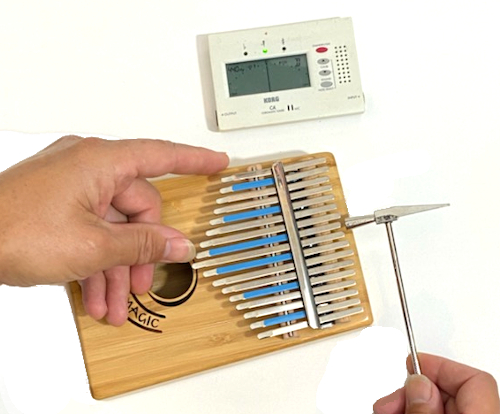
Use of this website constitutes acceptance of the Privacy Policy and User Agreement. Copyright © 2020 Kalimba Magic. All Rights Reserved.
Home > Info > How To Play > How to Tune the Kalimba

The most important thing you can do to sound good is to keep your kalimba in tune. If anyone tells you that kalimba tuning doesn’t matter, don’t believe them! Tunings were passed down in African villages from generation to generation. Of course, it is easier if you use an electronic tuner!

Kalimba tuning can be considered a noun and a verb at the same time. A kalimba’s tuning refers to what notes are where and how they sound together. To tune a kalimba is to actually adjust tines so they have the exact sound they are supposed to, according to which note a tine is designated to play.
The act of tuning could be to nudge a slightly detuned kalimba back into its previous tuning – that is, the notes will usually just be a wee bit out, and it is usually obvious what note each tine is supposed to be tuned to. On the other hand, the act of tuning (or retuning) could be to transform the kalimba at hand into a totally new and different tuning. The mechanics of these two tuning acts – restoring an old tuning or transforming to a new tuning – are largely the same. Every time you refine your tuning – a conservative act – you are gaining the skills you will need when you decide to transform your tuning – a radical act.
There are two issues: First, which tuning do you want? Second, how do you achieve that tuning? You can check out the specific “How to Play” page for your particular kind of kalimba to learn what tunings are available for that kalimba. But as to actually doing the tuning? Watch the following videos! Please keep in mind these two important things: One, an electronic tuner is important for accuracy. Two, I find that using my fingers gives me the best control when tuning, but others might use a pliers or other tool to help.
A video showing the principles of tuning a kalimba, and the difference
an alternate tuning can make in the kalimba sound.
Video showing me touch up the tuning of an Alto kalimba.
Most Hugh Tracey kalimbas will hold their tuning for several months. If you play very hard, you may need to retune weekly. If you drop your kalimba, or if you get the tines caught in a bag or on your shirt sleeve, you can mess up the tuning. Doing a touch-up on the tuning can take as little as a few minutes. While changing over to a different tuning can take me 5-10 minutes, you might want to budget 30-40 minutes on your first try.
When changing to a different tuning, make sure you know how to get back to the original tuning. Also, make sure that you can actually achieve that tuning. Making tines longer (from the point where they are held down on the bridge) will lower their pitch, and making them shorter will make their pitch higher. So it is good to consider, for example, whether a desired note is so low that a tine would not be long enough to actually make that note.
If you have difficulty tuning your kalimba, see the Kalimba Doctor, and he will do the deed for you:
Visit the Kalimba Doctor for Tuning
Also, after you tune up, make sure that the tines are more or less equally spaced. There is a mysterious phenomenon that sometimes happens – periodically, you will find that when you shift the tines to the left or right to get them equally spaced, you will “excite a buzz” in one of them. If this happens, shift the tine to an orientation where it does not buzz. Now you have to shift the neighboring tines (2-3 on each side) around to re-establish approximately equal spacing – and hopefully that process doesn’t excite one of those other tines to buzz too. Learn the many tricks we know about how to
fix a buzz on the Fundamentals page.
Once you have had some practice adjusting the tuning of your kalimba to put it back in tune, you might want to consider exploring some of the alternative tunings. Many tunings we offer at Kalimba Magic can be found on the Alto. Tunings page:
If you have any questions, feel free to contact us via the email form, or speak directly to Mark Holdaway at 520-488-7641. Contact Us


Sign up for our newsletter and free resources with your email address:
We pinky promise not to spam you and to only send good stuff.
 Assist Paul Tracey Rebuild His House in Pacific Palisades
Assist Paul Tracey Rebuild His House in Pacific Palisades 8-Note Spiral Kalimba Turned into a Student Karimba
8-Note Spiral Kalimba Turned into a Student Karimba Seek to Infuse Your Musical Moments With Beauty and Magic
Seek to Infuse Your Musical Moments With Beauty and MagicUse of this website constitutes acceptance of the Privacy Policy and User Agreement. Copyright © 2020 Kalimba Magic. All Rights Reserved.